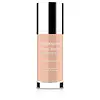Colourpop Hyaluronic Tinted Moisturizer Pretty Fresh Versus Neutrogena Hydro Boost Hydrating Tint for Dry Skin
What's inside
What's inside
 Key Ingredients
Key Ingredients

 Benefits
Benefits

 Concerns
Concerns

 Ingredients Side-by-side
Ingredients Side-by-side

Cyclopentasiloxane
EmollientWater
Skin ConditioningButylene Glycol
HumectantCetearyl Alcohol
EmollientTrimethylsiloxysilicate
EmollientDimethicone
EmollientPEG/PPG-18/18 Dimethicone
EmulsifyingCetyl PEG/PPG-10/1 Dimethicone
EmulsifyingPolypropylsilsesquioxane
Silica Silylate
EmollientSodium Hyaluronate
HumectantPyrus Malus Fruit Extract
Skin ConditioningCocos Nucifera Fruit Juice
EmollientCocos Nucifera Water
MaskingPotassium Sorbate
PreservativePolysorbate 20
EmulsifyingDisteardimonium Hectorite
StabilisingTribehenin
EmollientSodium Chloride
MaskingPropylene Carbonate
SolventCaprylyl Glycol
EmollientGlycerin
HumectantHexylene Glycol
EmulsifyingPhenoxyethanol
PreservativeIron Oxides
CI 77891
Cosmetic ColorantCyclopentasiloxane, Water, Butylene Glycol, Cetearyl Alcohol, Trimethylsiloxysilicate, Dimethicone, PEG/PPG-18/18 Dimethicone, Cetyl PEG/PPG-10/1 Dimethicone, Polypropylsilsesquioxane, Silica Silylate, Sodium Hyaluronate, Pyrus Malus Fruit Extract, Cocos Nucifera Fruit Juice, Cocos Nucifera Water, Potassium Sorbate, Polysorbate 20, Disteardimonium Hectorite, Tribehenin, Sodium Chloride, Propylene Carbonate, Caprylyl Glycol, Glycerin, Hexylene Glycol, Phenoxyethanol, Iron Oxides, CI 77891
Water
Skin ConditioningCyclopentasiloxane
EmollientDimethicone
EmollientDiphenylsiloxy Phenyl Trimethicone
Skin ConditioningButylene Glycol
HumectantGlycerin
HumectantDimethicone/PEG-10/15 Crosspolymer
Mica
Cosmetic ColorantPEG-9 Polydimethylsiloxyethyl Dimethicone
EmulsifyingDimethicone/Vinyl Dimethicone Crosspolymer
Skin ConditioningAcrylates/Dimethicone Copolymer
Skin ConditioningPhenoxyethanol
PreservativeMagnesium Sulfate
Hydroxyethylcellulose
Emulsion StabilisingDisodium EDTA
Chlorphenesin
AntimicrobialSodium Hyaluronate
HumectantAluminum Dimyristate
Emulsion StabilisingTriethoxycaprylylsilane
Disodium Stearoyl Glutamate
CleansingTitanium Dioxide
Cosmetic ColorantIron Oxides
Water, Cyclopentasiloxane, Dimethicone, Diphenylsiloxy Phenyl Trimethicone, Butylene Glycol, Glycerin, Dimethicone/PEG-10/15 Crosspolymer, Mica, PEG-9 Polydimethylsiloxyethyl Dimethicone, Dimethicone/Vinyl Dimethicone Crosspolymer, Acrylates/Dimethicone Copolymer, Phenoxyethanol, Magnesium Sulfate, Hydroxyethylcellulose, Disodium EDTA, Chlorphenesin, Sodium Hyaluronate, Aluminum Dimyristate, Triethoxycaprylylsilane, Disodium Stearoyl Glutamate, Titanium Dioxide, Iron Oxides
 Reviews
Reviews

Ingredients Explained
These ingredients are found in both products.
Ingredients higher up in an ingredient list are typically present in a larger amount.
Butylene Glycol (or BG) is used within cosmetic products for a few different reasons:
Overall, Butylene Glycol is a safe and well-rounded ingredient that works well with other ingredients.
Though this ingredient works well with most skin types, some people with sensitive skin may experience a reaction such as allergic rashes, closed comedones, or itchiness.
Learn more about Butylene GlycolCyclopentasiloxane, or D5, is a silicone used to improve texture of products and trap moisture.
D5 is considered lightweight and volatile. Volatile means it evaporates quickly after application. Once evaporated, D5 leaves a thin barrier that helps keep skin hydrated.
It is also an emollient. Emollients help soften the skin and prevent water loss. Silicones create a silky texture in products. D5 helps other ingredients become more spreadable.
Studies show D5 is safe to use in skincare products. We recommend speaking with a skincare professional if you have concerns.
Learn more about CyclopentasiloxaneDimethicone is a type of synthetic silicone created from natural materials such as quartz.
What it does:
Dimethicone comes in different viscosities:
Depending on the viscosity, dimethicone has different properties.
Ingredients lists don't always show which type is used, so we recommend reaching out to the brand if you have questions about the viscosity.
This ingredient is unlikely to cause irritation because it does not get absorbed into skin. However, people with silicone allergies should be careful about using this ingredient.
Note: Dimethicone may contribute to pilling. This is because it is not oil or water soluble, so pilling may occur when layered with products. When mixed with heavy oils in a formula, the outcome is also quite greasy.
Learn more about DimethiconeGlycerin is already naturally found in your skin. It helps moisturize and protect your skin.
A study from 2016 found glycerin to be more effective as a humectant than AHAs and hyaluronic acid.
As a humectant, it helps the skin stay hydrated by pulling moisture to your skin. The low molecular weight of glycerin allows it to pull moisture into the deeper layers of your skin.
Hydrated skin improves your skin barrier; Your skin barrier helps protect against irritants and bacteria.
Glycerin has also been found to have antimicrobial and antiviral properties. Due to these properties, glycerin is often used in wound and burn treatments.
In cosmetics, glycerin is usually derived from plants such as soybean or palm. However, it can also be sourced from animals, such as tallow or animal fat.
This ingredient is organic, colorless, odorless, and non-toxic.
Glycerin is the name for this ingredient in American English. British English uses Glycerol/Glycerine.
Learn more about GlycerinPhenoxyethanol is a preservative that has germicide, antimicrobial, and aromatic properties. Studies show that phenoxyethanol can prevent microbial growth. By itself, it has a scent that is similar to that of a rose.
It's often used in formulations along with Caprylyl Glycol to preserve the shelf life of products.
Sodium Hyaluronate is hyaluronic acid's salt form. It is commonly derived from the sodium salt of hyaluronic acid.
Like hyaluronic acid, it is great at holding water and acts as a humectant. This makes it a great skin hydrating ingredient.
Sodium Hyaluronate is naturally occurring in our bodies and is mostly found in eye fluid and joints.
These are some other common types of Hyaluronic Acid:
Learn more about Sodium HyaluronateWater. It's the most common cosmetic ingredient of all. You'll usually see it at the top of ingredient lists, meaning that it makes up the largest part of the product.
So why is it so popular? Water most often acts as a solvent - this means that it helps dissolve other ingredients into the formulation.
You'll also recognize water as that liquid we all need to stay alive. If you see this, drink a glass of water. Stay hydrated!
Learn more about WaterThis ingredient is a combination of red, black, and yellow iron oxide pigments. This combination of colors is usually found in foundation, because it results in a "skin" color.